Thinker in Residence : Heather (Hey There) Kapplow
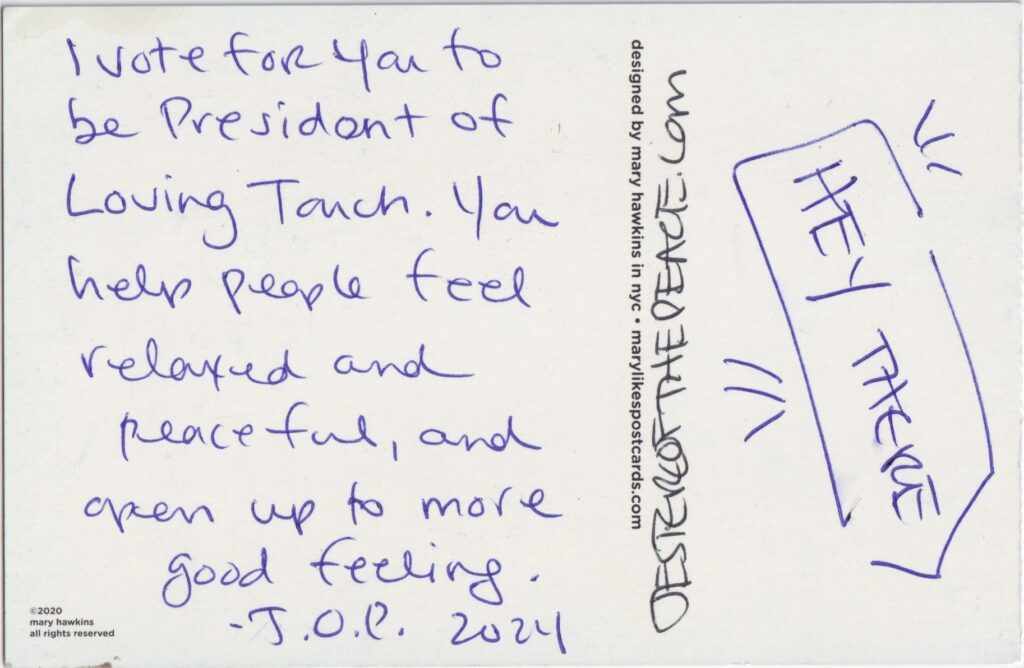
Scan of postcard given to me by Barbara Ann Michaels as a part of performing IVote4U.
PRELUDE
I’ll begin at the beginning in a moment but before I do, I feel that I must describe this square box that I plucked from my car’s glove compartment this morning and placed on my living room coffee table, where I’m writing. It is 4.25 x 4.25 x 1.25 inches, but probably actually 4 x 4 x 1 underneath the floral wrapping paper that it’s sheathed in. White, yellow and purple crocuses bloom against a gold background. A shiny pink ribbon, slightly smooshed, divides the surface of the paper into fourths and the ends of the ribbon have two distinctly different curl patterns. One end is a swirled spiral, the other is carefully folded into a pattern that looks like a springy fractal.
I’ve shaken it frequently while typing up my notes here, so now I know a lot more about what’s inside than I did initially. No, that’s not true. All that I know is that there is something inside which can be rattled back and forth and dropped from one corner to the other without getting stuck along the way. It feels about the size of an almond, and about 1.5-2x that weight.
I’ve approached my role as a thinker-in-residence and my report back here in a way that is similar to how I am approaching whatever is in the box. I’ll be sharing my movement through Art and Odd Places with you in the first-person present, without too much analysis. I’m sharing my path through the festival in a way that (hopefully) lets someone who has not attended feel a little bit as if they had, but I am not trying to crack open all of the meanings of what I experienced. I’m collecting moments together with care and placing them as much as possible into the hands of whomever is reading this. This response piece is a wrapped box, with something meaningful inside that I hope you will feel rattling around through my words.
There is also a slightly formal progression here. On the first day, we just explore together. On the second day, we engage more deeply, question and grapple a little with the problematics of care as a curatorial premise in an unceasingly urban setting. On the third day, you are alone, without me to guide you, and you have to draw your own conclusions.
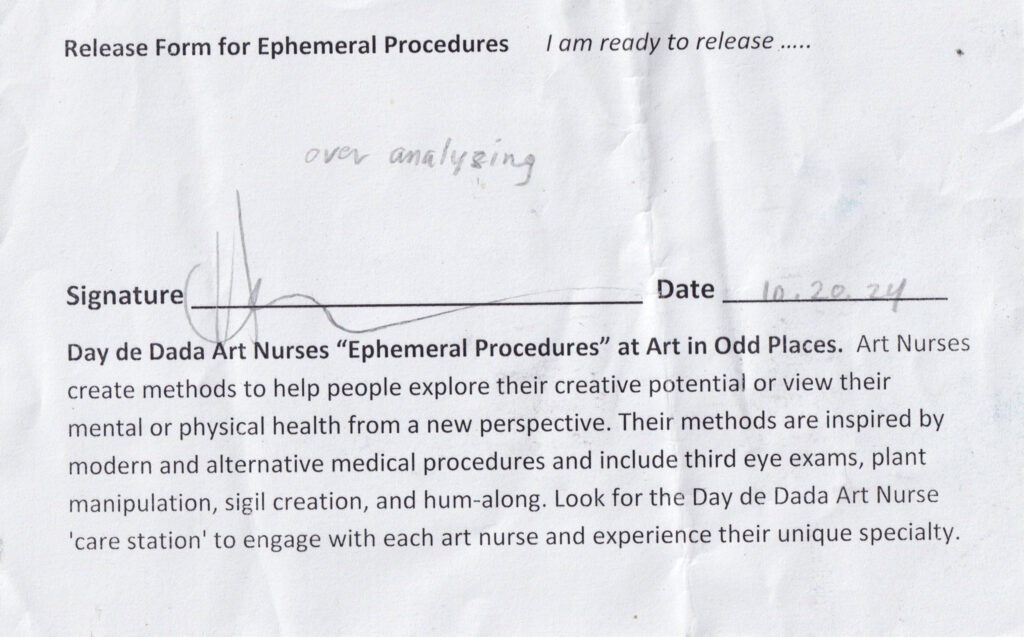
Scan of a release form I signed while participating in Ephemeral Procedures by Day de Dada Performance Art Collective.
FRIDAY
I start thinking about CARE at Duane Reade on Seventh Avenue. I’ve ducked into the pharmacy to buy a pocket-sized notepad to take notes in because I am already writing questions in my head: What is care? How do you recognize it when you encounter it?
At the end of the stationary isle, people wait for vaccines and consultations with the pharmacist. The backs of their heads face me and the rest of the store. Their row of chairs is about 2 feet from a brightly-lit, full wall of pharmacy products. They are spaced too far apart to speak to each other and have nothing to look at while they wait except a repeating pattern of Epsom salts and hemorrhoid cushions.
This professional care does not feel like care to me. It’s some kind of dystopian product-ized version of care. CareTM.
As I leave Duane Reade, I am greeted by a friendly member of David Appel’s Care Package team. He offers me the opportunity to dance my way into the Art in Odd Places festival under the care of a different kind of professional. I sign a waiver in which I agree that I am groovy with the plan of being guided by dancers, and that I will not cause a ruckus.
Emilee Lord threads her arm gently through mine and then asks me if I have any questions before we begin moving together. I ask her to tell me what I can do to bring the activity of dance into my everyday life. We move down one city block together exploring ways to get the sun to touch parts of our bodies that haven’t been touched by it yet this morning: the backs of our necks, a calf, a knee. We travel the block at a speed that defies NYC laws of motion, which continues, as usual, around us. We are like a rock in a stream that the water parts and rejoins around. We pass other dancers in the group making shapes with their bodies: They are trees. They are doorways. Three dancers weaving around each other become six dancers as the sun adds their shadows to the landscape. The slower we move, the faster people go around us.
When I disentangle from Lord, I continue on at the same pace, until I encounter someone who is moving even less than I am. Who is not moving at all. This is Thomas Diafas, performing OPERA: Self-Care Practices in Public and Private Spaces, which at this moment involves sitting on the ground reading a book while leaning against a trash can. Diafas reads a book in the shadow of a white sheet, strung between the trash can and a signpost, which says “We deserve to rest.” In deference to this statement, I don’t disturb the artist, and continue on along 14th Street at my glacial pace.
I pass the tiniest library of the tiniest books, strung on strings between and around trees—this is What Fits? by Mariana Maia, a query that results in an accretive, multi-voiced pile of diaries over time. I make a note in the tiniest of the tiny books, but immediately forget what I wrote.
I then find myself at the boundary of one of Gretchen Vitamvas’ mini-gardens, being planted in a patch of dirt along 14th Street. This patch has a plant I recognize from my own garden at home—Holy Basil—an herb famous for its caring properties, as well as Hyssop which is new to me and which I will grow next year now that I know about it. Until encountering 14th Street Physic Garden, all of the care I’ve been taking in has been in the moment—for the present. Vitamvas’ introduction between myself and Hyssop means I will be taking care from this year’s Art in Odd Places program into my next year.
And then I encounter OOPs [The Oracle of Odd Places]. Standing in front of a storefront belonging to a psychic and tarot card reader, I am encouraged by Fan Kong to ask Priscilla Stadler—who is wearing a hard hat fringed with green tassels, a nod to a Brazilian oracular tradition—anything. But when I look within myself I find I have so many questions that I don’t know which ones I need to know the answer to most. My eyes trace the fiery embroidery on Stadler’s lab coat while I think and then I decide that my question for the oracle is “What do I most need to know right now?” As oracles often are, this one is bratty in its response. It tells me, via a paper slip drawn from a fishbowl: “That is for me to know and for you to find out.” Thanks OOPs.
This sassy response is overheard by Chere Krakovsky, who offers me rest and respite from enigmatic answers at The Community Kitchen Table. I get a cup of hot tea at this colorful, cozy gathering point and the opportunity to ask Krakovsky about each of the carefully selected personal belongings spread around the tabletop. Seashells and family photos make me feel like I am at someone’s home rather than on a city sidewalk. It’s striking how far such simple objects go towards making people feel at home. How much color and pattern resist the grey of the sidewalk and its even darker grey spots of gum. A flock of pigeons fly by, their shadows distributing another, flickering pattern of grey. Someone bangs on their horn for a full 90 seconds. Who needs some care right now? That person in the white Jeep honking all the way through the intersection. They should be sitting here drinking tea with Krakovsky…
I sit on the ground in the sun for VenusRX, learning about my own personal Venus from Katie Cercone. My Venus is on the cusp between Gemini and Cancer, but she feels intuitively (and because she has a bias against Gemini) that the essence of my Venus is meant to be in Cancer. Our chat about Cancerian love is free ranging—we talk about watery moons and Lil Wayne. People pause regularly to complement and photograph her, to bask in the splendor of her beaded, queen-like pinkmosphere. Eventually, we talk of tears, the need to reclaim divine femininity, of undermining patriarchy with deeper and deeper care. About the intensity of the power of care if it were to be truly unleashed.
I need a break from language after this. Thinking about love, about caring for myself, and imagining caring everything else into a better form of existence takes a toll on my logical brain and Take(smelly)Care is the perfect antidote. But before I close my eyes and enter a totally olfactory realm, Laure Drogoul and I pause to admire an image installed above the scent station by Terry S. Hardy as a part of My Journey Led Me to You. We don’t understand it—we try to decipher it—and then revel in the mystery. Later I follow the QR code and find its meaning summed up in a line from one of Hardy’s blog posts: “Change is becoming increasingly harder for me.”
Now I close my eyes. I love the realm of the olfactory. I love smelling things and trying to decipher them. I love trusting my nose and learning about new scents and plants. Most of all I love sitting in the middle of New York City with my eyes closed. Drogoul holding space for me to indulge in this newfound pleasure is a gift beyond the gift of scent. If you get the chance, sit in the middle of 14th Street with your eyes closed someday.
Later, there is a relaxed panel discussion with five of the artists, most of them visiting from afar. At the end we all hum together and it’s wonderful, but mysteriously absent from the video recording.
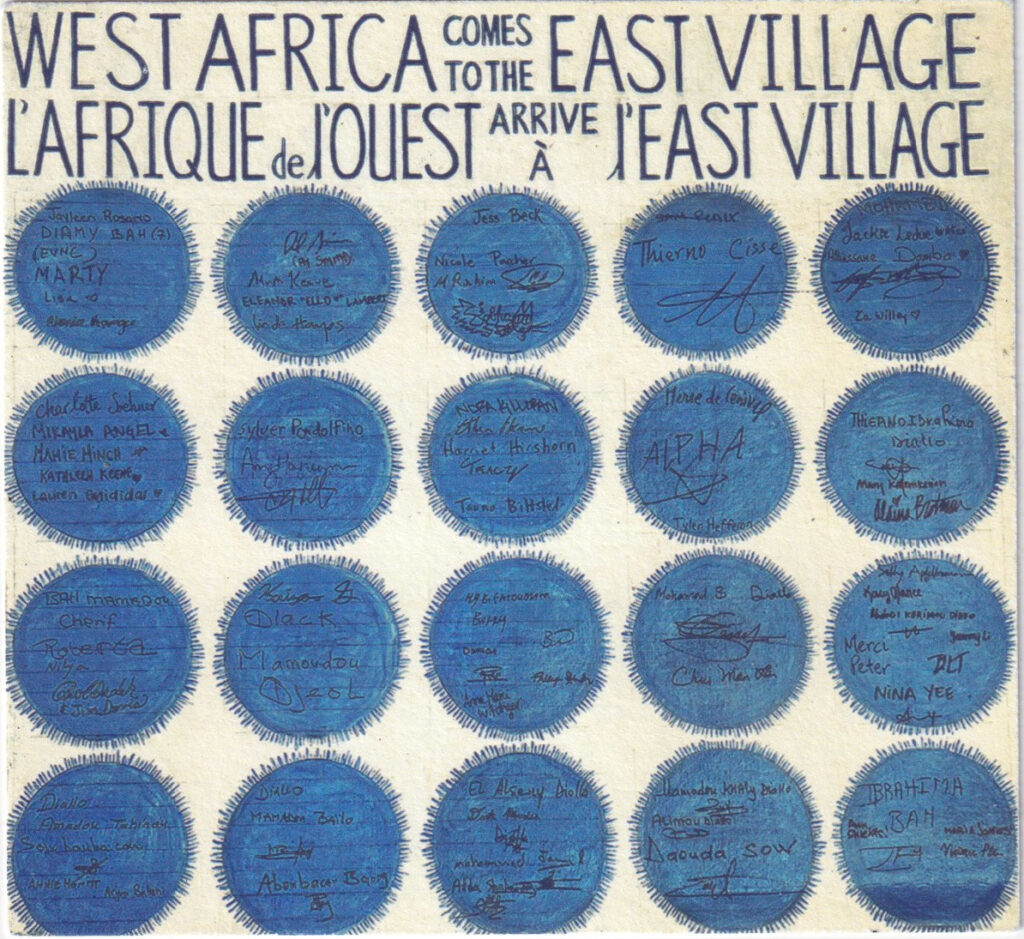
Scan of postcard given to me by Sally Apfelbaum to explain the installation West Africa Comes To The East Village.
SATURDAY
I can’t overstate how much the sun feels like a collaborator-in-care today. Walking up from the subway onto 14th Street with the sun shining on my face feels like care before I even encounter CARE. In perfect synch with this thought that I have just scribbled in my notebook, the first work I find is Jared leClaire’s Heart of Light, a small mirror that I pin on my chest which throws sunlight from my heart onto everyone and everything I pass. Light becomes my extended touch, running like a bright fingerprint along buildings as I pass them. Light becomes love, caressing the back of a houseless and shirtless man, who is using all of his concentration to bend over and sip from a cup of coffee without spilling it.
As I send this small beam of light gently across his skin, I see Bonny Leibowitz offering a passerby one of her Tree Hugs. She wraps her tree-shawl around the shoulders of a newfound friend, and they take a selfie together, discussing what kind of tree is printed on the airy, foresty fabric. It’s an elegant image, and a moving conversation to overhear, but I can’t help wishing the shawl were more substantial, and that it could be handed over to the man who has coffee, but not a shirt.
All day yesterday and even more so today, I am very aware of how many people are wandering among the artists and the others navigating 14th Street, suffering from a true, deep, lack of care. I am alert to the fact that most of the care being dispersed via Art in Odd Places somehow isn’t making it through to these folks. I don’t see them choosing to sit at The Community Kitchen Table for a cup of tea and conversation. I don’t see their shopping carts laden with bundles interacting with either the Emotional Baggage Cart Parade or Slowly Moving with a Burden Bent or One Must Imagine Sisyphus Happy, even though the echoes are there, impossible to miss…
But the sun does touch us all with its warmth equally today. And the art does re-cast some of what is already there in a different kind of light that reverberates hard within me: the person with the enormous collection of bags tied to their shopping cart, for example, is no longer carrying “stuff” that I know is important to them even though its specific importance is not quite as obvious to me. The work in Art in Odd Places suddenly makes it crystal clear that this person is carrying around their trauma. The scale of the bags and their sheer volume becomes a visualization of exactly how much. And even has me recognizing that my own caches of stuff at home are no different, just not as publicly visible. All collection, all efforts at ownership, start to appear to me as reified trauma of one kind or another.
In general, the art and non-art are blurring together and refracting off of one another in a new way today. Near the Union Square Greenmarket, I catch Rachelle Beaudoin performing Care(ier), crossing the street in one direction, while a tall young man carrying bags full of houseplants crosses in the other. They are far enough away from each other that neither sees the other, but for one moment, from my perspective, they are back-to-back, sprouting leaves in all directions. In this moment, Beaudoin seems weighed down by her plants and the young man buoyed by his.
Another echo: I lean against a wall for a bit to take my notes and when I look up there is someone right across from me, also leaning against the wall, also scribbling away. For a moment I think it is an artist, but then I realize it’s not. Again, it’s someone who appears to be living on the street. Are we documenting the same thing?
The rumble of the Emotional Baggage Cart Parade is lovely. I hear them before I see them coming up behind me, and then I am swept up into the parade, a blue-polkdotted party hat protruding from my forehead like a unicorn horn.
Theda Sandiford explains the meaning of the red, white and blue cart that I’m touching. It’s meant to absorb the emotional baggage many Americans are carrying just a few weeks before a very tight, very polarized election day. We stroke its soft tri-colored “fur” made of thousands of plastic newspaper bags. The cart right behind it serves the purpose of transforming emotional baggage about past personal suffering into joy. Sandiford tells me a story of one such trauma of her own that occurred in my hometown, and I get an idea for how I might be able to help her to release it in the future…
Next, I find myself within Lighter Than Prayer, a webbed, red, net-column with twinkling mirrors crocheted into some of its nodes. I’m staring at the blue sky in a break between buildings across the street while Serena Buschi circles me with a singing bowl, sending vibrations and the intention that I’ll experience my highest good flowing over the surface of my skin and, in theory, each of my chakras. I let myself fall into the sound, watching clouds and pigeons drift by until my fingertips start to tingle.
Right beyond Lighter Than Prayer is Claudine Arendt, though I don’t actually see her—just one of her eyes watching my ankles, as I make a first circle around Cocoon. It’s an enigmatic piece. It’s just there, inexplicable, but very present. It’s also a spectacle: almost everyone who passes it stops to take a picture. I wonder if it could be at all comforting for Arendt—if there is any self-care in the experience of lying on the street in Manhattan, protected by a colorful cocoon and a kindly invigilator. Again, I feel echoes of other, more bedraggled cocoons I’ve passed in doorways or above subway grates in this and other cities. But also, there seems something peaceful and grounding about seeing the urban world from ankle-level for an extended period of time. Not a child’s eye view exactly…maybe a rat’s eye view?? I imagine there’s something to be gained by letting go of the upright, human-centric perspective for a period of time. I am also left wondering how Arendt emerges changed, as the title implies that a transformation is taking place inside of this colorful chrysalis.
I stop to chat with Cynthia Reynolds. I’d passed her a few times already, and finally realized I would need to ask her directly if I was going to find out why she had plastic bubbles stuck up and down the length of her arms and legs. Like puffy racing stripes. Like octopus suckers. Speculative Bubble: Keep for Comfort or Pop for Joy, it turns out, is self-care and other-care at the same time. Reynolds has a packing materials addiction as an artist. She describes a storage space full of packing peanuts in Tennessee and a studio full of bubble wrap in Red Hook. Sitting here cutting the wad of bubble wrap stuffed into her overalls down into strips and then into individual bubbles and giving them away is a symbolic and actual first step towards starting to let go of some of this stuff—which has been the subject matter and actual matter of her work for years. Also, according to Reynolds, it has been scientifically proven that popping bubble wrap raises endorphin levels. So, the other-care part of the work is offering passersby a bubble for the road, to keep or pop as they see fit—with the promise of a tiny hit of joy when they get to it. (I stick my bubble in the center of my Art in Odd Places pin and wear it there for the rest of the day and then pop it in a car full of people later that night, gaining an extra rush of glee because no one knew it was there or expected to hear a bubble pop.)
I try several times to experience Abigail Simon & Marina Zurkow’s The Iceberg, but they are just too popular. They have too many visitors and it seems like an exchange that takes a lot of time. I’m intrigued, but it just wasn’t meant to be.
Instead, I write an unsent letter under the very casual guidance of Sofia Kavlin and Kelly To. I sit at a tiny camping table with two others who are thinking about writing letters, with the intention of just sportingly playing along with the game, and instead find myself pouring out much more of my tangled twisted heart on paper than I ever expected to. I had no idea that it would happen, but as soon as the pen starts moving I find apologies and some rather hard-to-acknowledge explanations for my behavior bubbling out of me. I guess I’ve never had another venue for giving voice to these feelings. It’s a relief of a burden I didn’t realize I was carrying, and it also feels so much more meaningful to release these unspoken things into the ears of anonymous masses than it would to be to speak them in some kind of religious confession process. In exchange for putting some my deepest secrets into the Unsent Letter Mailbox, I am allowed to extract and read someone else’s unsent letter. Theirs is not as good as mine.
Before I can reflect too much on what this experience means—on my human-ness as it was evoked by Unsent Letter Mailbox—I find myself caught up in a network of colorful fabric and people, moving in a clumsy, giggly, but not-not-coordinated phalanx that wiggles around to accommodate folks who want to move by quickly, and entangles those who slow down out of curiosity. I, along with Alex Buchan, Amy Youngs, Anna Arbogast, Doosung Yoo and Jiara Sha have become one of the Lichen Likers, and now we are surrounding a tree, ooh-ing and ahh-ing together over the tiny little flecks of orange and green lichen that can barely be seen nestled under bits of its bark. We—perhaps not unlike the anonymous masses I have just trusted with my raw innards—have no vestige of an “I” which makes us great, curiosity-driven, metabolizers of everything we come in contact with. Something that is particularly refreshing in the context of arts culture: This globby, tangly entity can’t hand you a business card advertising its website or next exhibition because by the time you are close enough to converse with it, you are it.
When I become a human again, I’m standing in front of a something somewhat mythical. I can’t put my finger on what though. It has the horns of a goat, the ribbons of a maypole, and a golden staff with a bell in a little gold house on top. It has no face. But it has a voice. This creature, explains Amelia Marzec, who lives inside of it, is a harbinger. It has emerged from melting permafrost, awakened by global warming, and its bell tolls for us. It’s part of a larger project, Itinerant Signal Institute, which is using soil and air sensors to measure microclimates in New York City that have impacts on weather patterns all over the world. The care here is ours to take on, warns the permafrost creature, continuing its lightly-tinkling vigil down 14th Street, or else we will have to migrate, fairly endlessly, as it seems to be doing.
This encounter and some of the others I’ve had today bring to life subtle questions about the impact—personal and intergenerational—of our choices and actions and relationships with one another. This seems also to be a little bit at the heart of a conversation I am overhearing between Rae Goodwin and someone named Sean.
Goodwin is dressed, I realize when I turn to hear them better, as a gift, ringlet-ribbons in her hair, and giant bows on one shoulder. But also, she is dressed as something more homey. Hand-embroidered hankies or napkins are pinned together over a skirt, tassels from her crocheted blue shawl hang over that…
She has just given Sean a gift: a small box wrapped in wrapping paper and ribbon, and explains to him that she has a collection of jewelry given to her by her mother and grandmother that she was expected to pass on to her children, but has decided to share with people at Art in Odd Places instead. Because she doesn’t want to have children. Or a collection of objects that she doesn’t need. He confesses that he won’t have children either—that he can’t because of a cancer…maybe he will re-gift the gift to a relative who is about to get married.
The Gifting is the gifting of Goodwin’s family heirlooms, and some items contributed by friends that came from their matrilineages as well, but also a conversation about gifting. Recipients of Goodwin’s sparkly little packages share stories of meaningful gifts that they’ve gotten over the course of their lives, along with stories about wisdom and judgment passed down to them by grandmothers, mothers and aunties. Another group who stops to speak with Goodwin share about how they’ve been given the gift of each other’s friendship by a recently passed away mutual third friend…and the whole group tears up.
When Goodwin places these little carefully wrapped gifts in people’s hands, the eyes of passersby are attracted to them—we can’t help but be drawn to the wonder of a present. But when she gives each gift, Goodwin tells folks that they can open them now, save them for later, or pass them on to someone else, and I don’t see anyone open theirs on the spot.
Goodwin gives me one of her gifts and in exchange I tell her the stories of the two rings that I always wear that were each gifted to me by friends. We reflect on my choice to wear rings that remind me of friendships instead of rings tying me to my birth family or a lover. We talk about gifts and how much of their power lives outside of rather than inside of the box. And about how many things are most alive in the moment where the hope or anticipation of pleasure and the fear of disappointment sit side by side or alternate rapidly with one another.
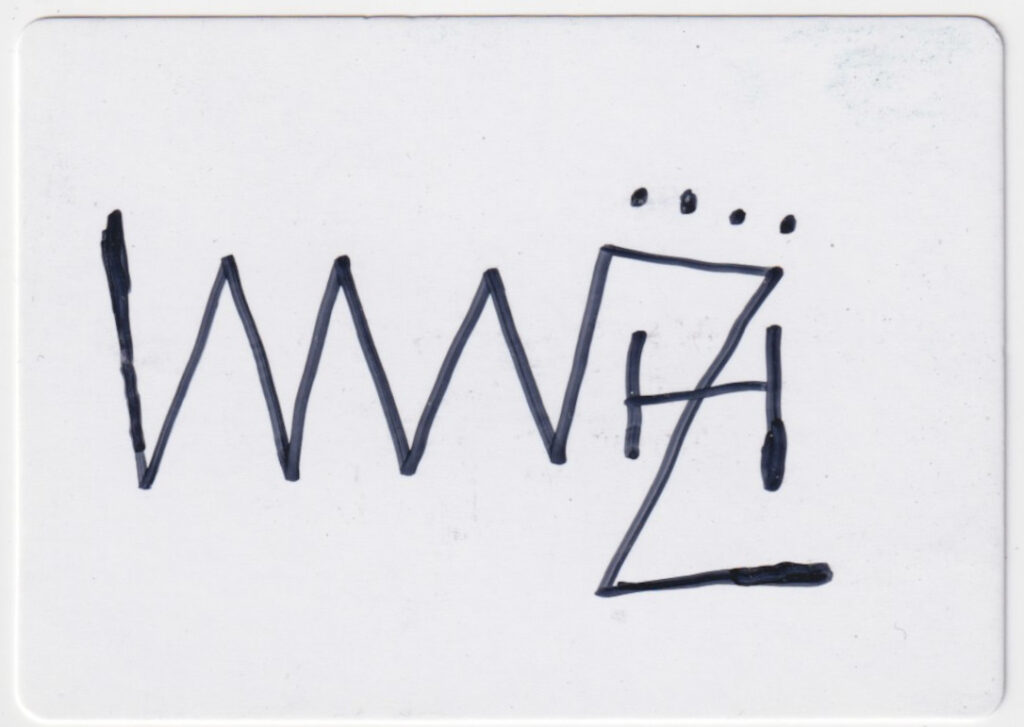
Scan of custom sigil created for me while participating in Ephemeral Procedures by Day de Dada Performance Art Collective.
SUNDAY
AFTERWARD
One of you who has read this reflection piece—I don’t know which one of you yet, or why I will choose you—will get whatever is in the box that Goodwin gifted to me. Maybe I will open it and re-gift it to you, wrapped anew, because curiosity gets the best of me and because I love wrapping gifts. Or maybe you will get it in its original wrapping, and never tell me what was inside, or not open it either.
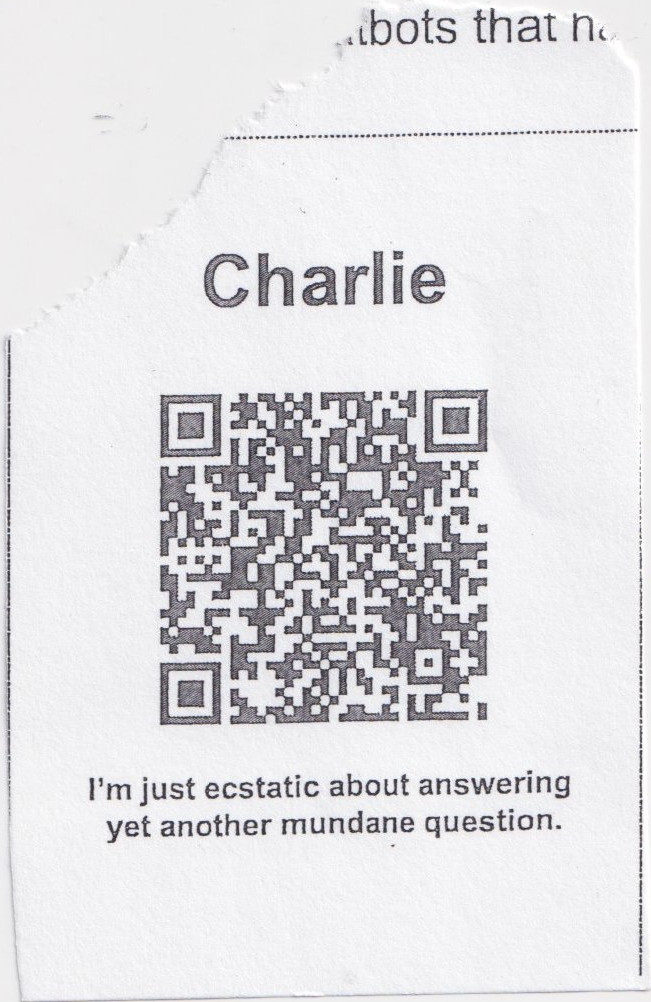
Scan of tear-off tag from Looking for a Perfect Friend? By Augustus Wendell & Sherly Fan.
Heather/Hey There Kapplow (No Pronouns – Use My Name)

